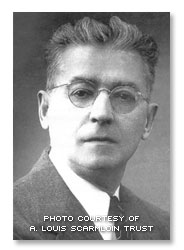
Anthony Louis Scarmolin (1890-1969)
Anthony Louis Scarmolin was born in 1890 in the northern Italian textile-producing town of Schio, near Padua, where his father worked in the local factory. His father moved to United States in 1900, taking his family with him and settling in New Jersey. The elder Scarmolin also provided his talented young son with his first instruction on the violin and, it is thought, the piano.
At an early age Scarmolin showed undeniable signs of talent. As a teenager he enrolled in New York’s German Conservatory of Music, where he continued his piano studies with Bertha Cahn. At this time he also began to compose. Apparently the work of an autodidact, Scarmolin’s earliest pieces mystified his teachers. His early style, contemporaneous with Schoenberg’s early departures from tonality and with Bartók’s String quartet No. 1, did not survive their criticism. Why he left this youthful voice behind, never to retrieve it in later works, remains and unsolved mystery. It was therefore as a pianist that he graduated from the conservatory. Sadly, as fate would have it, a debilitating hand condition forced the cancellation of a planned Carnegie Hall début recital. Although he eventually recovered, he abandoned the idea of a performing career. Reshaping himself as a commercial composer, he threw himself into the composition of sacred and light classical songs, pedagogical and salon music for piano and simple choral works. These he sent to various publishers, who gradually began to publish them. At the same time he continued to write "serious" works, evidently harbouring the ambition of conquering the stage. His first operas date from this period and one of them, The Interrupted Serenade, was later submitted to the Metropolitan Opera by Beniamino Gigli, eventually to be rejected by the programming committee.
Scarmolin served with the U.S. Army in World War I, playing the clarinet and, when possible, the piano, with the 320th Field Artillery Band. He continued to write predominantly "marketable" music during this time, adding patriotic songs to his repertory. Upon his return from the army he found work as a band and orchestra director at Emerson High School in Union City, New Jersey and served in this capacity, well-loved by his students, for thirty years, until auditory problem forced an early retirement in 1949. In 1926 he married a voice teacher and singer, Aida Balasso, who devoted herself to her husband’s career. The couple were childless and travelled frequently to Italy.
During the 1920s and early 1930s Scarmolin seems to have devoted himself even more to being commercially successful, apparently making time by limiting his production of "art music". His artistic ambitions seem to have reawakened about 1935, the year he composed his First Symphony. From this time on, though, he continued to compose quantities of pedagogical piano music, as well as pieces for student ensembles of all kinds. Scarmolin was a modest and private man who kept his inner life to himself, more of an eighteenth century cut, perhaps, than his Romantic melodic and harmonic language would lead one to suspect. Even during the global trauma of World War II his titles reflect an insulation from the outside world. Scarmolin continued to compose compulsively, for commercial and artistic applications despite his ill health. He died in 1969.






























